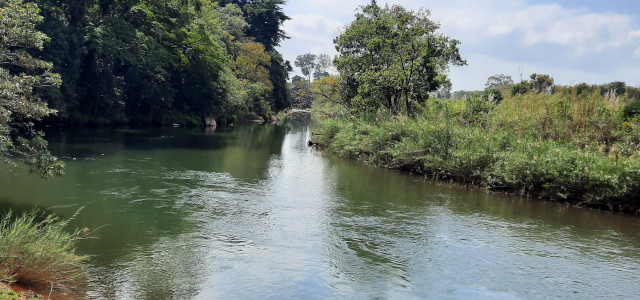The study was conducted by a consortium of specialists led by Southern Waters Ecological Research & Consultancy, under the Global Environment Facility (GEF)- funded USD 6 million “Management of Competing Water Uses and Associated Ecosystems in Pungwe, Buzi, and Save Basins ” Project, being implemented by the International Union for Conservation of Nature (IUCN), with Global Water Partnership Southern Africa (GWPSA) as the regional executing partner supporting the basin’s member states.
The study explained how the river and nearby areas work, what affects their health, and how they support people and nature. It identified important points where changes could harm these environments and the benefits they offer.
The biodiversity existence value of the Pungwe Basin, based on its species richness and a rough estimate of global willingness to pay for biodiversity conservation, was calculated to be in the region of USD 59 million/year, which amounts to USD 61/ha/year. This figure highlights the significant existence value of the basin’s remaining natural ecosystems, stemming from its high mammal species richness which is more than double the global average. The aquatic ecosystems of the Pungwe Basin were estimated to generate goods and services with a gross value of approximately USD 448.3 million per year. Avoided climate change costs through carbon retention contributed most of this, at USD 285 million per year.
The study also assessed how various management approaches and water resource development scenarios might help deliver on the spirit and specifics of the Pungwe Basin Water Sharing Agreement between Mozambique and Zimbabwe.
Rural and urban settlements, agriculture, afforestation, and gold panning were identified as the main sources of estuary water pollution. Overall, the study recommended that water-resource development in the Pungwe Water-Sharing Agreement should be combined with investments in environmental protection and sustainable utilisation of natural resources.
The assessment is expected to inform negotiations around transboundary water allocation and ecological flows in the Pungwe basin as provided by the Pungwe Water Sharing Agreement as well as subsequent ecosystem restoration projects to halt biodiversity loss.
The Buzi, Pungwe, and Save Watercourses Commission (BUPUSACOM) is mandated by the governments of Mozambique and Zimbabwe to provide a forum for consultation and coordination to promote integrated water resources management and development within the Pungwe Basin.
Biological diversity or biodiversity refers to the variety of living species on earth, including plants, animals, bacteria, and fungi, and the natural patterns they form. Many species are being threatened with extinction due to human activities, putting the earth’s magnificent biodiversity at risk.
The Global Assessment Report on Biodiversity and Ecosystem Services of 2019 cited climate change, invasive species, over-exploitation of natural resources, pollution, and urbanization as the main global drivers of biodiversity loss.
All organisms within an ecosystem are interconnected such that when the diversity of organisms within an ecosystem declines, the ecosystem’s ability to function and survive decreases. Biodiversity underpins human wellbeing both now and, in the future, and its rapid decline poses a threat to both nature and humans.The Living Planet Report 2022 released by the World Wildlife Fund, cited a 68 percent decline in populations of vertebrate animals (mammals, birds, amphibians, reptiles and fish) between 1970 and 2022.
Global Actions Against Biodiversity Loss
The global community has come together to seek measures for the protection of targeted threatened species through agreements, treaties, policies, and laws from international down to grassroots levels.
One of the most important international environmental treaties is the Convention on Biological Diversity (CBD), a 196-member treaty that seeks to address all threats to biodiversity and ecosystem services. Under this convention is theKunming-Montreal Global Biodiversity Framework (Biodiversity Plan), which sets out an ambitious roadmap for halting and reversing nature loss.The framework consists of 23 action-oriented global targets to be achieved by 2030 and beyond to safeguard and sustainably use biodiversity.
The Convention on International Trade in Endangered Species of Wild Fauna and Flora (CITES) is also an important treaty between governments, aiming to ensure that international trade in specimens of wild animals and plants does not threaten the survival of the species.
Other important treaties on biodiversity include the Convention on the Conservation of Migratory Species of Wild Animals (Bonn Convention), for the conservation of migratory species, and the UNESCO World Heritage Convention, for the protection and preservation of cultural and natural heritage. The Ramsar Convention on Wetlands provides the framework for the conservation and sustainable use of wetlands, while the Convention on the Prevention of Marine Pollution by Dumping of Wastes and Other Matter (London Convention), the 1982 Convention on the Law of the Sea and the 2009 Agreement on Port State Measures focus on protecting marine ecosystems.
As we commemorate International Day for Biological Diversity , governments, non-governmental organizations, lawmakers, businesses, and individuals are called to re-examine their relationship with biodiversity and transform their roles and actions towards nature.
At national levels, governments are required to develop policies and legislative frameworks for the conservation of biodiversity and encouraged to mainstream them into sectoral policies to address the pressing issue of sustainable development while safeguarding the world’s rich natural heritage. Countries that are parties to the Kunming-Montreal Global Biodiversity Framework are called by the CBD to develop National Biodiversity Strategy and Action Plans (NBSAP), to provide them with strategic direction at a national level on the management and protection of biodiversity.
The global community is also urged to improve its understanding and awareness of biodiversity while increasing humanity’s recognition of the significant challenges its activities pose to biodiversity. As we progress towards the 2030 Sustainable Development Goals mark, let us cooperate to protect and restore biodiversity for the benefit of nature and humankind and to secure a sustainable future for all.
This Opinion Editorial was written by Dr Loreen Katiyo, Transboundary Water Governance & Environmental Specialist-GWPSA and Leticia Ngorima, Regional Communications Specialist-GWPSA in observation of International Day for Biological Diversity 2024.
